Kenwood USA 29383120 UHF-FM Mobile Transceiver User Manual TK 760G 860G front cover
Kenwood USA Corporation UHF-FM Mobile Transceiver TK 760G 860G front cover
Manual
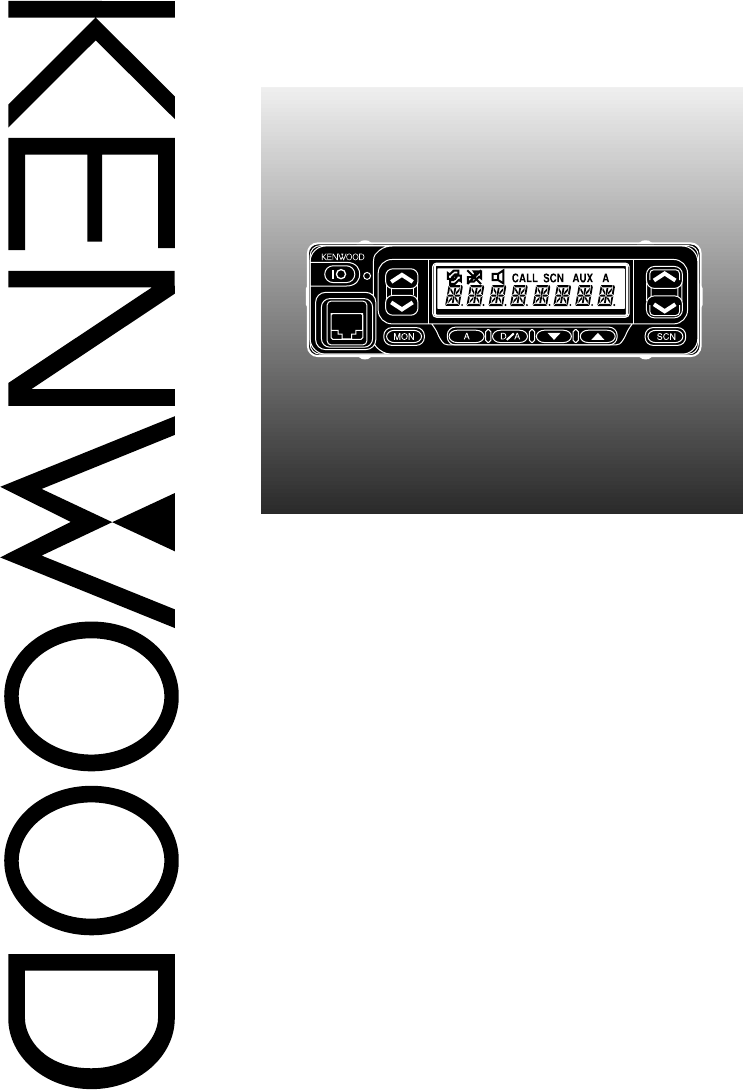
TK-760G
INSTRUCTION MANUAL
VHF FM TRANSCEIVER
© B62-1258-00 (K, M)
09 08 07 06 05 04 03 02 01 00
KENWOOD CORPORATION
TK-860G
UHF FM TRANSCEIVER

THANK YOU!
We are grateful you chose KENWOOD for your personal mobile applications. We
believe this easy-to-use transceiver will provide dependable communications to keep
personnel operating at peak efficiency.
KENWOOD transceivers incorporate the latest in advanced technology. As a result,
we feel strongly that you will be pleased with the quality and features of this product.
MODELS COVERED BY THIS MANUAL
The models listed below are covered by this manual:
•TK-760G: VHF FM Transceiver
•TK-860G: UHF FM Transceiver
One or more of the following statements may be applicable:
FCC WARNING
This equipment generates or uses radio frequency energy. Changes or modifications to this
equipment may cause harmful interference unless the modifications are expressly approved in the
instruction manual. The user could lose the authority to operate this equipment if an unauthorized
change or modification is made.
INFORMATION TO THE DIGITAL DEVICE USER REQUIRED BY THE FCC
This equipment has been tested and found to comply with the limits for a Class B digital device,
pursuant to Part 15 of the FCC Rules. These limits are designed to provide reasonable protection
against harmful interference in a residential installation.
This equipment generates, uses and can generate radio frequency energy and, if not installed and
used in accordance with the instructions, may cause harmful interference to radio communications.
However, there is no guarantee that the interference will not occur in a particular installation. If this
equipment does cause harmful interference to radio or television reception, which can be determined
by turning the equipment off and on, the user is encouraged to try to correct the interference by one or
more of the following measures:
•
Reorient or relocate the receiving antenna.
•
Increase the separation between the equipment and receiver.
•
Connect the equipment to an outlet on a circuit different from that to which the receiver is
connected.
•
Consult the dealer for technical assistance.

i
◆
GOVERNMENT LAW PROHIBITS THE OPERATION OF UNLICENSED RADIO
TRANSMITTERS WITHIN THE TERRITORIES UNDER GOVERNMENT CONTROL.
◆
ILLEGAL OPERATION IS PUNISHABLE BY FINE OR IMPRISONMENT OR BOTH.
◆
REFER SERVICE TO QUALIFIED TECHNICIANS ONLY.
SAFETY: It is important that the operator is aware of, and understands, hazards
common to the operation of any transceiver.
WARNING!
◆
EXPLOSIVE ATMOSPHERES (GASES, DUST, FUMES, etc.)
Turn OFF your transceiver while taking on fuel or while parked in gasoline service stations.
Do not carry spare fuel containers in the trunk of your vehicle if your transceiver is mounted
in the trunk area.
◆
INJURY FROM RADIO FREQUENCY TRANSMISSIONS
Do not operate your transceiver when somebody is either touching the antenna or standing
within two to three feet of it, to avoid the possibility of radio frequency burns or related
physical injury.
◆
DYNAMITE BLASTING CAPS
Operating the transceiver within 500 feet of dynamite blasting caps may cause them to
explode. Turn OFF your transceiver when in an area where blasting is in progress, or where
“TURN OFF TWO-WAY RADIO” signs have been posted. If you are transporting blasting
caps in your vehicle, make sure they are carried in a closed metal box with a padded interior.
Do not transmit while the caps are being placed into or removed from the container.
NOTICES TO THE USER
PRECAUTIONS
Please observe the following precautions to prevent fire, personal injury, and
transceiver damage.
•Do not attempt to configure the transceiver while driving; it is too dangerous.
•Do not modify the transceiver for any reason.
•Do not expose the transceiver to long periods of direct sunlight, nor place it
near heating appliances.
•Do not place the transceiver in excessively dusty, humid, or wet areas, not on
unstable surfaces.
•If an abnormal odor or smoke is detected coming from the transceiver, turn
OFF the power immediately. Contact your KENWOOD dealer.

ii
CONTENTS
UNPACKING AND CHECKING EQUIPMENT
SUPPLIED ACCESSORIES ............................................................................ 1
PREPARATION
TOOLS REQUIRED ......................................................................................... 2
POWER CABLE CONNECTION ..................................................................... 2
INSTALLING THE TRANSCEIVER ................................................................. 3
ORIENTATION
FRONT PANEL AND MICROPHONE.............................................................. 4
DISPLAY........................................................................................................... 5
REAR PANEL................................................................................................... 5
PROGRAMMABLE AUXILIARY FUNCTIONS ..................................................... 6
PROGRAMMABLE FUNCTIONS .................................................................... 6
BASIC OPERATIONS
RECEIVING ...................................................................................................... 8
Switching Powr ON/OF ............................................................................ 8
Adjusting the Volume ............................................................................... 8
Selecting a Channel ................................................................................. 8
CALLING .......................................................................................................... 9
Monitoring the channel ............................................................................ 9
Busy Channel Lockout ............................................................................ 9
Time-Out Timer ......................................................................................... 9
ADVANCED OPERATIONS
SCANNING CHANNELS ................................................................................. 9
Priority Scan ............................................................................................. 9
Channel lockoul ........................................................................................ 9
TALK-AROUNDl ............................................................................................ 11
2-TONE SIGNALLING ................................................................................... 11
Select and encodeing 2-tone signalling .............................................. 11
HORN ALERT ................................................................................................ 12
OPERATOR SELECTABLE TONE................................................................ 12
PUBLIC ADDRESSS ..................................................................................... 12
AUX ................................................................................................................ 12
DTMF (DUAL TONE MULTI FREQUENCY) CALLS
MAKING A DTMF CALL ................................................................................ 13
Auto Dialing............................................................................................. 13
Manual Dialing ........................................................................................ 13
Store and Send Dialing .......................................................................... 13
DTMF SIGNALLING ...................................................................................... 14
DBD (DEAD BEAT DISABLE) ....................................................................... 14

1
UNPACKING AND CHECKING EQUIPMENT
Note: The following unpacking instructions are for use by your KENWOOD dealer, an authorized
KENWOOD service facility, or the factory.
Carefully unpack the transceiver. We recommend that you identify the items
listed in the following table before discarding the packing material. If any items
are missing or have been damaged during shipment, file a claim with the carrier
immediately.
SUPPLIED ACCESSORIES
Microphone and
microphone cable DC power cableMicrophone hanger
with self-tapping screws
Mounting bracket Screw setSpeaker jack cap
metI rebmuNtraP ytitnauQ
elbacenohporcimdnaenohporciMXX-7950-19T1
swercsgnippat-fleshtiwregnahenohporciMXX-4851-91Jtes1
elbacrewopCDXX-9333-03E1
tekcarbgnitnuoMXX-7260-92J1
packcajrekaepSXX-5320-90B1
:teswercS
XX-5930-99N1
)seceip4(wercsgnippat-fleS•
)seceip4(rehsawhtiwwercsdedaeh-xeH•
)seceip4(rehsawgnirpS•
)seceip4(rehsawtalF•
)A01(esuFXX-1600-15F2
)ylnoadanaC/.A.S.U(dracytnarraW––1
launamnoitcurtsnIXX-7521-26B1
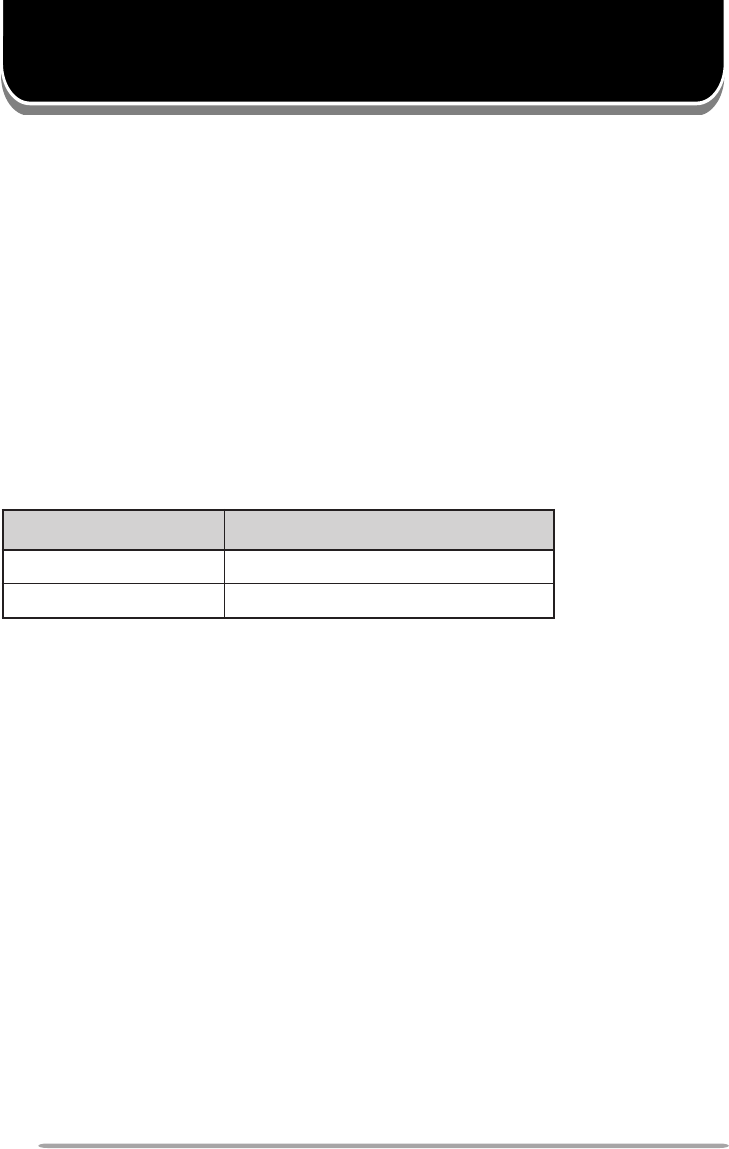
2
WARNING! VARIOUS ELECTRONIC EQUIPMENT IN YOUR VEHICLE MAY MALFUNCTION IF THEY
ARE NOT PROPERLY PROTECTED FROM THE RADIO FREQUENCY ENERGY WHICH IS
PRESENT WHILE TRANSMITTING. ELECTRONIC FUEL INJECTION, ANTI-SKID BRAKING, AND
CRUISE CONTROL SYSTEMS ARE TYPICAL EXAMPLES OF EQUIPMENT THAT MAY
MALFUNCTION. IF YOUR VEHICLE CONTAINS SUCH EQUIPMENT, CONSULT THE DEALER FOR
THE MAKE OF VEHICLE AND ENLIST HIS AID IN DETERMINING IF THEY WILL PERFORM
NORMALLY WHILE TRANSMITTING.
Note: The following preparation instructions are for use by your KENWOOD dealer, an authorized
KENWOOD service facility, or the factory.
TOOLS REQUIRED
Note: Before installing the transceiver, always check how far the mounting screws will extend below the
mounting surface. When drilling mounting holes, be careful not to damage vehicle wiring or parts.
The following tools are required for installing the transceiver:
•6 mm (1/4 inch) or larger electric drill
•Drill bits (sizes listed below) and circle cutters
POWER CABLE CONNECTION
CAUTION: THE TRANSCEIVER OPERATES IN 12 V NEGATIVE GROUND SYSTEMS ONLY!
CHECK THE BATTERY POLARITY AND VOLTAGE OF THE VEHICLE BEFORE INSTALLING THE
TRANSCEIVER.
1Check for an existing hole, conveniently located in the firewall, where the
power cable can be passed through.
•If no hole exists, use a circle cutter to drill the firewall, then install a rubber
grommet.
2Run the two power cable leads through the firewall and into the engine
compartment, from the passenger compartment.
3Connect the red lead to the positive (+) battery terminal and the black lead to
the negative (–) battery terminal.
•Locate the fuse as close to the battery as possible.
4Recoil and secure the surplus cable with the provided retaining band.
•Be sure to leave enough slack in the cables so the transceiver can be removed for
servicing while keeping the power applied.
PREPARATION
eziStiBllirD esopruP
)hcni23/5(mm2.4swercsgnippat-flesmm61x5
)hcni8/1(mm2.3swercsgnippat-flesmm61x4
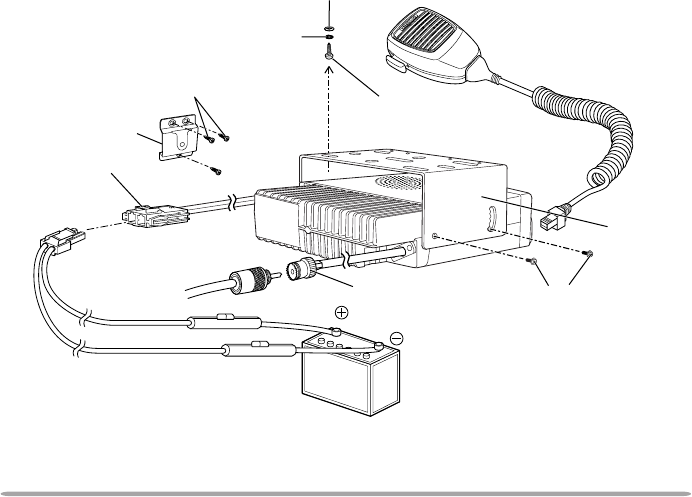
3
INSTALLING THE TRANSCEIVER
WARNING! FOR PASSENGER SAFETY, INSTALL THE TRANSCEIVER SECURELY, USING THE
SUPPLIED MOUNTING BRACKET, SO THE TRANSCEIVER WILL NOT BREAK LOOSE IN THE
EVENT OF A COLLISION.
1Mark the position of the holes in the dash by using the mounting bracket as a
template. Drill the holes, then attach the mounting bracket using the supplied
5 x 16 mm screws.
•Be sure to mount the transceiver in a location where the controls are within easy
reach of the user, and where there is sufficient space at the rear of the transceiver
for cable connections.
2Connect the antenna and the supplied power cable to the transceiver.
3Slide the transceiver into the mounting bracket and secure it using the
supplied hex-headed screws.
4Mount the microphone hanger, using the supplied 4 x 16 mm screws, in a
location where it will be within easy reach of the user.
•The microphone and microphone cable should be mounted in a place where they
will not interfere with the safe operation of the vehicle.
5Connect one plug of the microphone cable to the jack on the base of the
micropohone, and the other plug to the microphone jack on the front panel of
the transceiver. Place the microphone on the hanger.
Hex-headed screw
Microphone
hanger
DC power cable
Mounting
bracket
5 x 16 mm
self-tapping screw
4 x 16 mm
self-tapping screw
Spring washer
Flat washer
Antenna
connector
Power input
connector
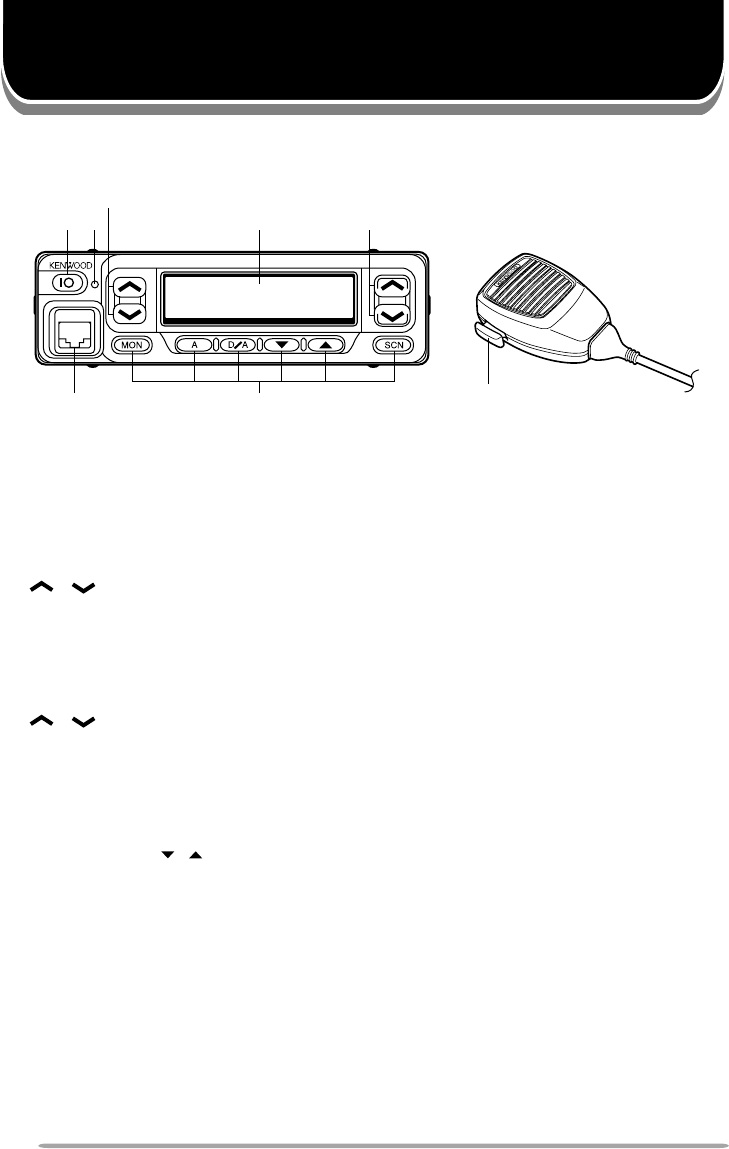
4
ORIENTATION
FRONT PANEL AND MICROPHONE
qq
qq
qIO (Power) switch
Press to switch the transceiver ON (or OFF).
ww
ww
wStatus LED
Red LED indicats that the transceiver is transmitting. Green LED indicates
that the transceiver is receiving the signal.
ee
ee
e / keys
Press these keys to activate their programmable auxiliary functions
{page 7}. Default setting is VOLUME Up/Down keys.
rr
rr
rDisplay
See page 5 for more information.
tt
tt
t / keys
Press these keys to activate their programmable auxiliary functions
{page 7}. Default setting is Channel Up/Down keys.
yy
yy
yMicrophone connector
Insert the microphone plug into this connector.
uu
uu
uMON, A, D/A, , , and SCN keys
Press these keys to activate their programmable auxiliary functions
{page 7}.
ii
ii
iPTT switch
To transmit, press and hold this switch, then speak into the microphone.
Release to receive.
q
yu
wrt
e
i
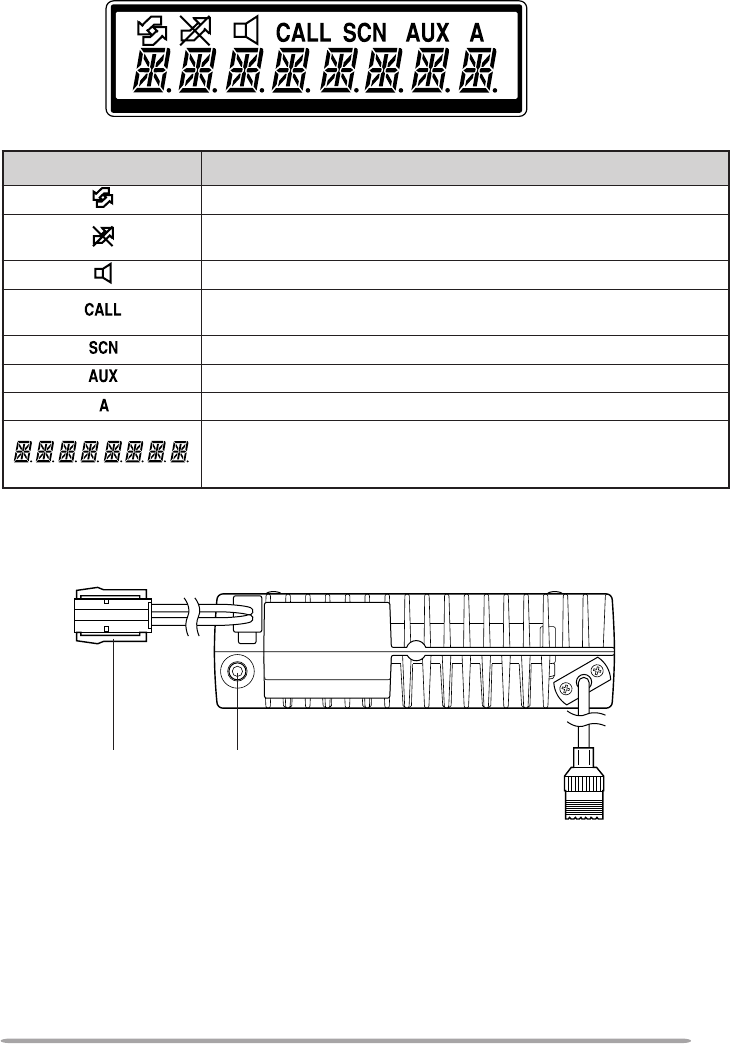
5
DISPLAY
REAR PANEL
External
speaker jack
Power input
connector
Antenna connector
rotacidnI noitpircseD
.reviecsnartsihtnodesutonsinocisihT
detcelesyltnerrucehtnotneserperaslangisnehwsraeppA .lennahc
.detavitcasinoitcnufrotinoMehtnehwsraeppA
enot-2demmargorperphtiwdellacevahuoynehwsraeppA .ytraprehtonamorfllacevitcelesFMTDroedocgnillangis
.gninnacssireviecsnartehtelihwsraeppA
.resuehtybdetavitcasitropXUAelihwsraeppA
.”tsilnacS“nisilennahcdeyalpsidehtnehwsraeppA
puorg,srebmunlennahcehtsyalpsidtI.yalpsidniamA ehtmargorpnacrelaedruoY.sutatssuoiravdnasrebmun .srebmunfoecalpni,sretcarahc01otpuhtiwsemanlennahc
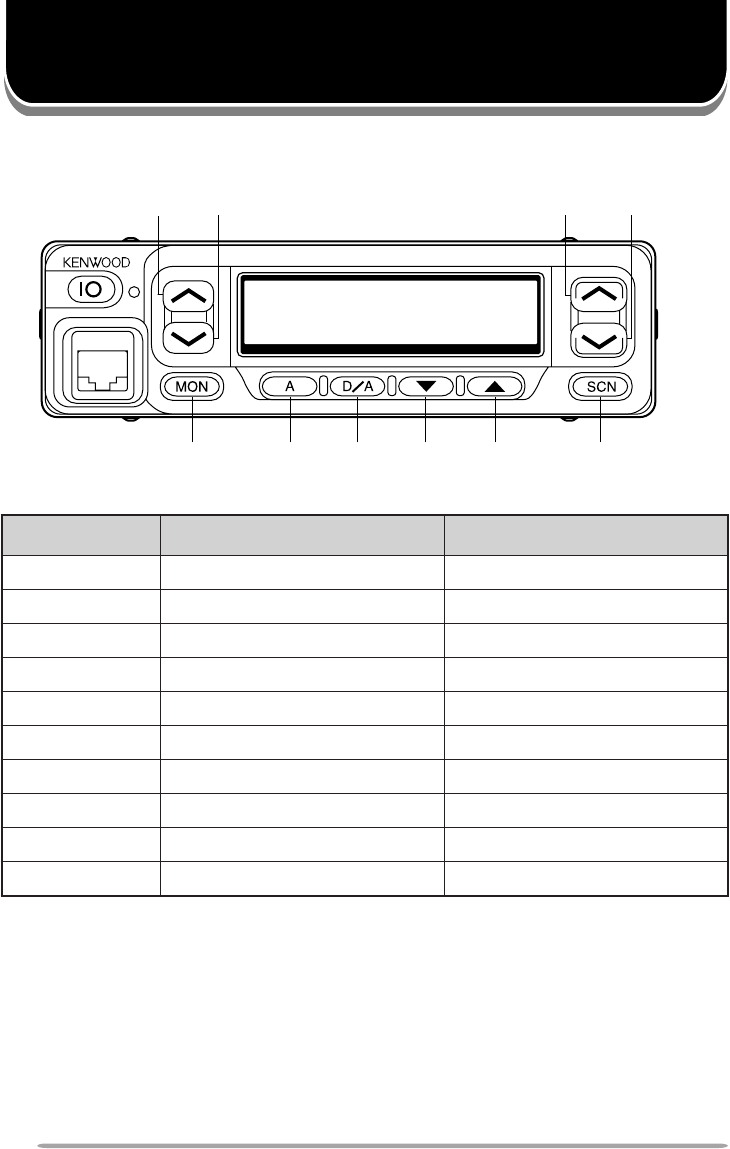
6
PROGRAMMABLE AUXILIARY FUNCTIONS KEYS
The following keys can be programmed with the auxiliary functions listed in the
table on next page.
Note:
◆
For your reference, please fill out the form above with the programmed function by your dealer.
◆
A list of the programmable functions is available on the next page.
rebmuNyeK gnittesoidarruoY gnittestluafedyrotcaF
qpUemuloV
wnwoDemuloV
epUlennahC
rnwoDlennahC
tArotinoM
y---
u---
i---
o---
0! ---
q
t y u i o !0
wer

7
PROGRAMMABLE FUNCTIONS
1This function can be used only with a foot switch.
emantrohS noitpircseD
XUA
tropXUAetavitcA
nwoDlennahC
rebmunlennahcehtesaerceD
pUlennahC
rebmunlennahcehtesaercnI
retcarahCyalpsiD
puorG,yalpsidrebmunlennahcneewtebelggoT emanlennahcciremun-ahpladnayalpsid yalpsid
ycnegremE
1
edomycnegremeehtetavitcA
nwoDpuorG
rebmunpuorgesaerceD
pUpuorG
rebmunpuorgesaercnI
lennahCemoH
lennahcemohteserpaotnruteR
trelAnroH
noitcnuftrelAnroHetavitcA
kcoLyeK
yekrewopatpecxesyekllakcoL
ArotinoM ))yratnemoM(etumnUrotinoM(
yeksihthsupuoyelihwlennahcehtrotinoM
))elggoT(etumnUrotinoM(BrotinoM
ffodnanonoitcnufrotinomelggoT
CrotinoM ))yratnemoM(hcleuqSreirraC(
ehtnepodnagnillangisenot-2/TQD/TQelbasiD .ylnoreirracgnimocniehthtiwhcleuqs
))elggoT(hcleuqSreirraC(DrotinoM
dnanonoitcnufehtselggoT.evobasaemaS ffo
noitcnufoN
noitcnufoN
)ylnoepyt-K(enoTelbateleSrotarepO
61morftesenotatcelesresuateL sriapenotTQD/TQdemmargorperp
sserddAcilbuP
noitcnufsserddAcilbuPetavitcA
laideR
rebmuntsalehtlaideR
nacS
ruoyybdemmargorpsaslennahcehtnacS relaed
ddA/leDnacS
gninnacsehtot/morflennahcehtddaroeteleD tsillennahc
dnuorAklaT
ycneuqerfeviecerehtnotimsnartotecroF
nwoDemuloV
emulovehtesaeceD
pUemuloV
emulovehtesaercnI
tceleSedocnEenoT-2
enot-2demmargorperp01fo1tcelesresuateL .sriap

8
BASIC OPERATIONS
RECEIVING
Your dealer may have programmed QT or DQT signalling for the channel that
you select. If the channel has been programmed in this way, you will hear
transmissions from your group only. Otherwise, you will hear all the
transmissions made any stations using the same channel.
■ Switching Power ON/OFF
Press the IO switch to switch the transceiver ON (or OFF).
■ Adjusting the Volume
Press the key programmed as Volume Up or Volume Down to adjust the
volume. Volume Up increases the volume and Volume Down decreases it.
■ Selecting a Channel
Select the desired channel system using the keys programmed with the Channel
Up and Down keys.
Note: TK-760G/ TK-860G features 128-channel capacity. In order to manage 128 channels easily, one
or more programmed channels can be bundled together as a group.
Your dealer may have also programmed Group Up and Down keys. In this case, please select the
desired group and channel number. Please consult your dealer for the details.

9
CALLING
■ Monitoring the channel
Press MON key (or a key programmed as Monitor) to monitor the channel for
a few seconds to confirm that channel is not being used.
After the confirmation, hold the microphone about 3 to 4 cm (1 1/2 inches)
from your mouth, press microphone PTT , and speak in your normal speaking
voice.
Release PTT and listen to a response.
■ Busy Channel Lockout
Activated or deactivated by your dealer, this function prevents you from
interfering with other stations that my be using a channel. Pressing
microphone PTT while the selected channel is in use causes your transceiver
to generate an audible warning tone. Your transceiver is inhibited in this
situation so it will not transmit. Release microphone PTT to canel the alarm
and restore the receive mode.
■ Time-Out Timer
The purpose of the time-out timer is to automatically interrupt continuous
transmissions after a specified time elapses. Holding down microphone PTT
for longer than the programmed time causes the transceiver to stop
transmitting and generate a warning tone. Releasing microphone PTT
cancels the warning tone.

10
SCANNING CHANNELS
If the Scan function is enabled, groups or channels can be scanned by pressing
the key programmed as Scan. A Scan key can be programmed as either Single
Scan or Multi Scan by your dealer.
Single Scan monitors only the channels of a single group. Multi Scan monitors
all channels of every group. When the Scan key is pressed, the SCN indicator
and "SCAN" appear on the display and the scanning starts.
When a call is received on one of scanning channels, scanning stops and the
channel information appears on the display. Press PTT switch and speak into
the microphone to respond to the call. The transceiver will continue scanning
after an adjustable time delay, if PTT switch is released, and no further signal is
received.
■Priority Scan
Either Fixed priority scan or Selectable priority scan may be programmed by
your dealer.
•Fixed Priority Scan: The pre-programmed channel is monitored in a
certain interval while scanning. When the signal is being received on this
priority channel while scanning, you will be transfered to this priority
channel.
•Selectable Priority Scan: After you select the priority channe using
Channel Up/Down or Group Up/Down keys, press a Scan key,
programmed by your dealer. The scanning starts and the selected priority
channel is monitored in a certain interval while scanning. When the signal
is being received on the selected priority channel while scanning, you will
be transfered to this priority channel.
■Channel lockout
If the channel lockout is enabled by your dealer, you can select channels to
add or delete from the scaning channel list. When the displayed channel is
not locked out from the scanning, the add indicator A (Add) will appear on the
display.
1. Using Channel Up and Down key to select the channel that you wish to
add or delete from the scanning list.
2. Press a Delete/Add key, programmed by your dealer to add or delete the
channel to/from the scanning channel list. If the channel is in the scanning
list, A (Add) indicator will be lit on the upper right side of the display. A
(Add) indicator is disappeared from the display, the channel is no longer in
the scanning channel list.
ADVANCED OPERATIONS

11
TALK-AROUND
Occasionally, a power failure or other cause at the repeater may result in an
interruption of service. Your dealer may have provided the Talk-around function
for use in such cases. This function allows communication directly with other
tranceivers without using a repeater. However, even Talk-around may not allow
you to contact a station if the distance is too far or there are geographic
obstacles in the way.
To enable Talk-around function, press a key, programmed as Talk-around.
"TA" or "T." (depending on the configuration) will be displayed at the left side of
LCD display.
Note: When you are in Talk-around mode, all the signalling data, such as QT,
DQT, 2-tones are still enabled.
2-TONE SIGNALLING
2-tone signalling is either enabled or disabled by your dealer. 2-tone opens the
squelch only when the transceiver receives the preset two sequential tones that
have different frequencies.
When the correct tones are received that were programmed by your dealer, the
squelch opens, and the caller's voice is monitored.
■Select and encoding 2-tone signalling
If "2-tone encode select" is programmed by your dealer, you can select 1
of 10preset 2-tone codes. Then you can sent the desired 2-tone to
another party.
1 Press a key, programmed as 2-tone encode select .
2 Select the desired a tone set, using Channel Up and Down key.
3 Press 2-tone encode select key again to set.
4 Press PTT to send the tone to another party.

12
HORN ALERT
When a call is received that has correct DTMF codes or 2-tone signalling, Horn
Alert causes the vehicle horn or some other external alert to sound. This
function notifies you of a received call when you are out of the vehicle.
1 To activate the Horn Alert, press the function key programmed as Horn Alert.
2 To disable the Horn Alert, press a Horn Alert function key again to return to
the normal operation.
OPERATOR SELECTABLE TONE
If this function is enabled by your dealer, you can change the default QT and
DQT tone frequencies. You can select 1 of 16 decode/ encode pairs, that is
preset by your dealer.
1 Use Channel Up and Down key to select the desired channel
2 Press a key, programmed as Operator Selectable Tone.
3 Use Channel Up and Down key to select a desired tone pair.
4 Press a key in step 2 again to return to the normal display.
PUBLIC ADDRESS
To use Public Address, the optional PA unit (KAP-1) and external speaker must
be installed by your dealer. This function amplifies audio input from the
microphone and outputs amplified audio from the external speaker.
1 Press the function button programmed by your dealer with this function
2 Press PTT and speak into the microphone.
Note: To adjust the audio output from the external speaker, please use Volume Up and Down keys to get
the appropriete sound.
3 To return to the normal operation, press the PA function key again.
AUX
A control port has been provided for an external board, such as a Voice
Scrambler. Pressing the function button programmed by your dealer, activates
or deactivates the AUX port.

13
DTMF (DUAL TONE MULTI FREQUENCY) CALLS
MAKING A DTMF CALL
Note: To make a DTMF call, you must have an optional microphone with a DTMF keypad. Ask your
dealer for more information.
There are three ways of making a DTMF call:
•Auto dialing
•Manual dialing
•Store and send dialing
■ Auto dialing
1Press * key on DTMF microphone.
2Press one of numeric key, 1~9.
•Preprogrammed numbers appears on the display.
3 Push PTT to send the numbers
Note:
◆
Maximum length of the proprogrammed number is 16 digits.
■ Manual dialing
1Press and hold the PTT switch.
2Enter the desired digits using the microphone keypad.
•The corresponding DTMF tones sound each time you press a key.
•If you release the PTT switch, transmit mode will end even if the complete number
has not been sent.
•If your dealer has activated the Keypad Auto PTT function, you need not hold down
the PTT switch while pressing the keys on the keypad. The DTMF code will be
sent automatically when you press a key.
■ Store and send dialing
1Enter the desired digits using the microphone keypad.
•The digits appear on the display as you enter them.
2After entering the complete number, press the PTT switch.
•The DTMF code is transmitted after pressing the PTT switch.
Note:
◆
Store and send must first be activated by your dealer in order for it to function.
◆
You can only store up to 16 digits before sending. Entering more than 16 digits will cause an error
tone to sound.
◆
In store and sending mode, if you switch the power OFF before sending the number, the number will
be cleared from memory.

14
DTMF SIGNALLING
Your dealer can program a group or channel with DTMF signalling. When you
receive a call with a code that matches yours, a tone will sound. Squelch opens
and you will hear the call.
Squelch will close when you receive a call with a code that matches your
signalling reset code.
When making a call on a group or channel programmed with a DTMF signalling
code, the indicator will light and the squelch will open.
If your dealer programmed Transpond for DTMF signalling, your transceiver will
automatically send an acknowledgment signal to the station that called you with
the correct DTMF code.
DBD (DEAD BEAT DISABLE)
Depending on how your dealer programs your transceiver, when you receive a
call containing a DBD code, either transmit mode or receive and transmit modes
will be disabled. When a DBD code is received, a tone will sound.
DBD is cancelled when you receive a call with a DBD cancel code.